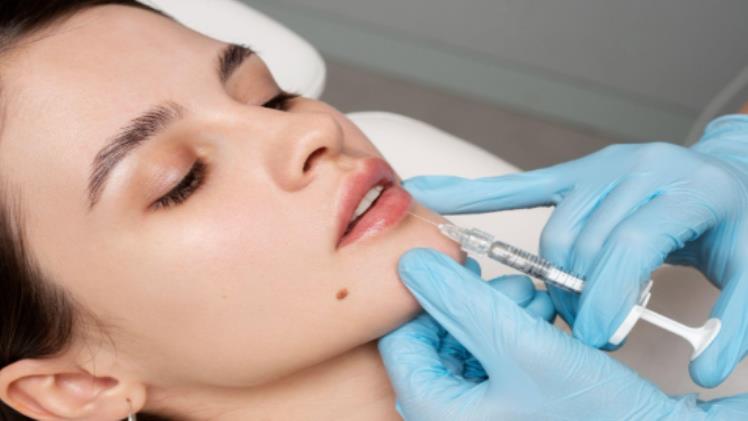Lip fillers are injections designed to add volume to the lips and are a popular choice in cosmetic procedures. These dermal fillers primarily consist of synthetic hyaluronic acid (HA), a substance naturally found in our bodies. The demand for lip fillers has risen significantly, individuals are increasingly turning to lip fillers to enhance lip volume, correct asymmetries, smooth wrinkles, and improve self-esteem. This growing trend reflects the desire for a confident smile through cosmetic advancements. Learn more about lip filler in this article!
What Are Lip Fillers?
Lip fillers involve injecting dermal filler into the upper and lower lips to enhance their plumpiness and create your desired lip shape. This treatment can also be used to define the cupid’s bow or to lift the corners of the mouth, addressing concerns like downturned lips or uneven corners. After the injection, the corners of the mouth will be slightly lifted, resulting in a more beautiful lip shape. The results are visible immediately after the procedure.
Why Do People Choose Lip Fillers?
Many people opt for lip fillers for diverse reasons. A major factor is the desire for fuller lips that enhance facial aesthetics. Others seek to restore lost volume due to aging, correct asymmetrical shapes, or smooth wrinkles around the mouth.
Importantly, lip augmentation can significantly boost self-image and confidence. The allure of a more defined smile drives individuals towards this cosmetic enhancement, highlighting the intersection of personal choice and beauty standards in today’s society.
Lip Filler Preparation
To ensure the best and safest results from your lip filler treatment, it’s crucial to follow your clinic’s instructions diligently and understand key information beforehand. Proper preparation helps maximize the effectiveness of the filler and minimizes the risk of side effects. Here’s what you should know and do before your lip filler injection:
- Learn about the specific brands of lip fillers available and the unique characteristics of each model. This will help you understand what to expect.
- Make sure the clinic sources its fillers legitimately, only using products imported from authorized medical suppliers.
- Your doctor should be highly experienced in administering fillers, have a verifiable identity, and possess a valid medical license number.
- Inform your doctor about any previous facial injections or cosmetic surgeries you’ve had.
- Always tell your doctor about any drug allergies, medications you take regularly, existing medical conditions, and if you are pregnant. This is vital for reducing the risk of complications.
- For two weeks before your injection, stop taking certain vitamins and supplements that can affect blood circulation, such as Vitamin C. This helps prevent easy bruising after the lip filler treatment.
Lip Filler Aftercare

Post-procedure, you’ll need to take care of your lips to ensure proper healing. Expect some swelling and tenderness for a few days. It’s advisable to avoid strenuous activities, sun exposure, and certain skincare products for a short period. Here’s proper aftercare advise from the doctor:
- Do not massage, press, pick, scratch, or squeeze the injection sites on your lips. Also, do not try to reshape the filler yourself, as this can distort the shape your doctor created.
- For the first 4-5 days, to reduce bruising and swelling, avoid alcoholic beverages, strenuous exercise, and any vitamins or supplements that can increase blood circulation. This will help prevent prolonged swelling and bruising.
- Any bruising or swelling after lip filler injections is normal and will gradually improve within 7-14 days; it’s not harmful to your body.
- For 14 days after your injection, avoid areas with high heat, such as saunas. Also, ensure you drink plenty of water consistently. Hyaluronic acid fillers absorb water, which helps the lip filler plump up fully and look more natural.
- f you notice the injection site turning pale white, purple, or red, contact your clinic immediately. These symptoms could indicate that the filler has entered a blood vessel, which requires urgent attention to prevent complications.
Possible Risks and Side Effects of Lip Filler
Despite their popularity, lip fillers come with risks. Complications can range from minor issues like swelling and bruising to more serious effects such as tissue death resulting from improper injection techniques.
Therefore, it’s crucial to choose an experienced injector, preferably a certified healthcare provider, to minimize risks. Understanding these potential side effects will help set realistic expectations and prepare you for the experience.
How Long Do Lip Filler Results Last?
Lip fillers typically last between 6 to 12 months. Factors influencing the longevity of results include age, metabolism, and the type of filler used. Younger individuals may metabolize the fillers more quickly, requiring more frequent touch-ups to maintain the desired lip volume. Generally, refreshing your lip fillers every year ensures your lips retain their desired fullness.
Should You Get Lip Filler?
Lip fillers can empower individuals to enhance their appearance and boost self-confidence. Always consider aspects such as safety, professional administration, and the temporary nature of these fillers. By consulting with a healthcare professional experienced in lip augmentation, you can achieve your desired look while minimizing risks.
Prioritize exploring personal goals and preferences with your provider, ensuring the best outcomes aligned with your expectations. Always remember to stay informed and prioritize safety for your lip filler journey.








Leave a Comment